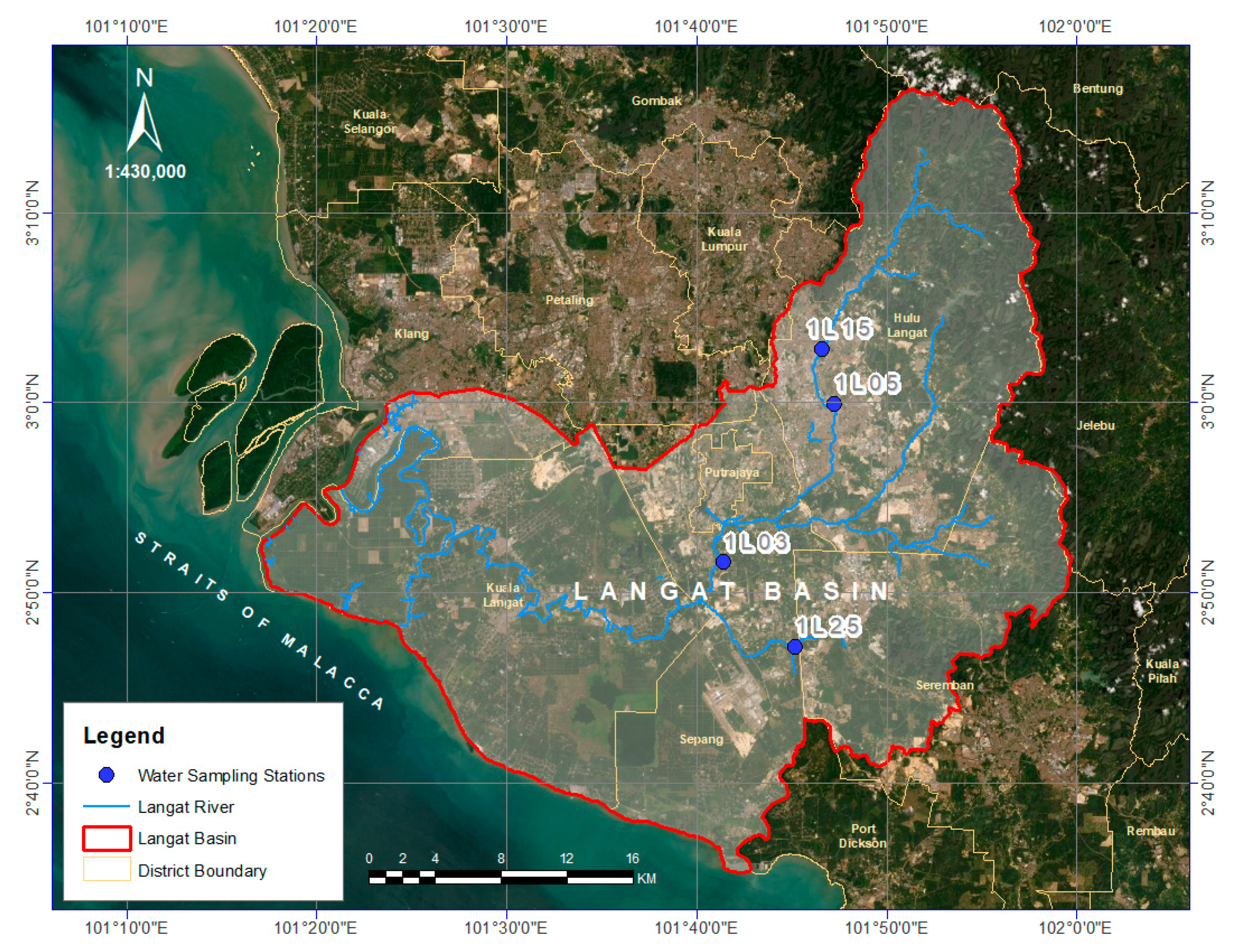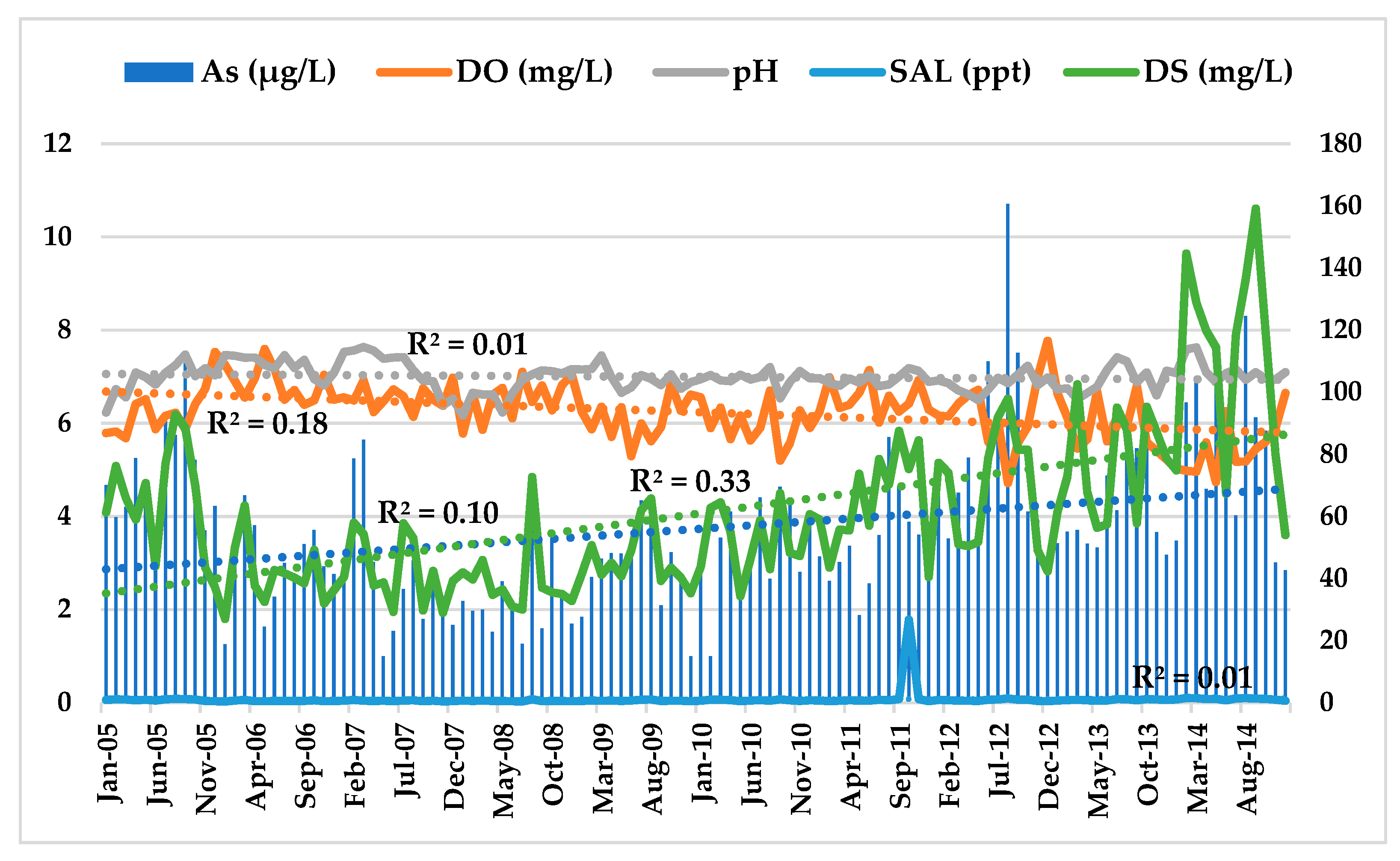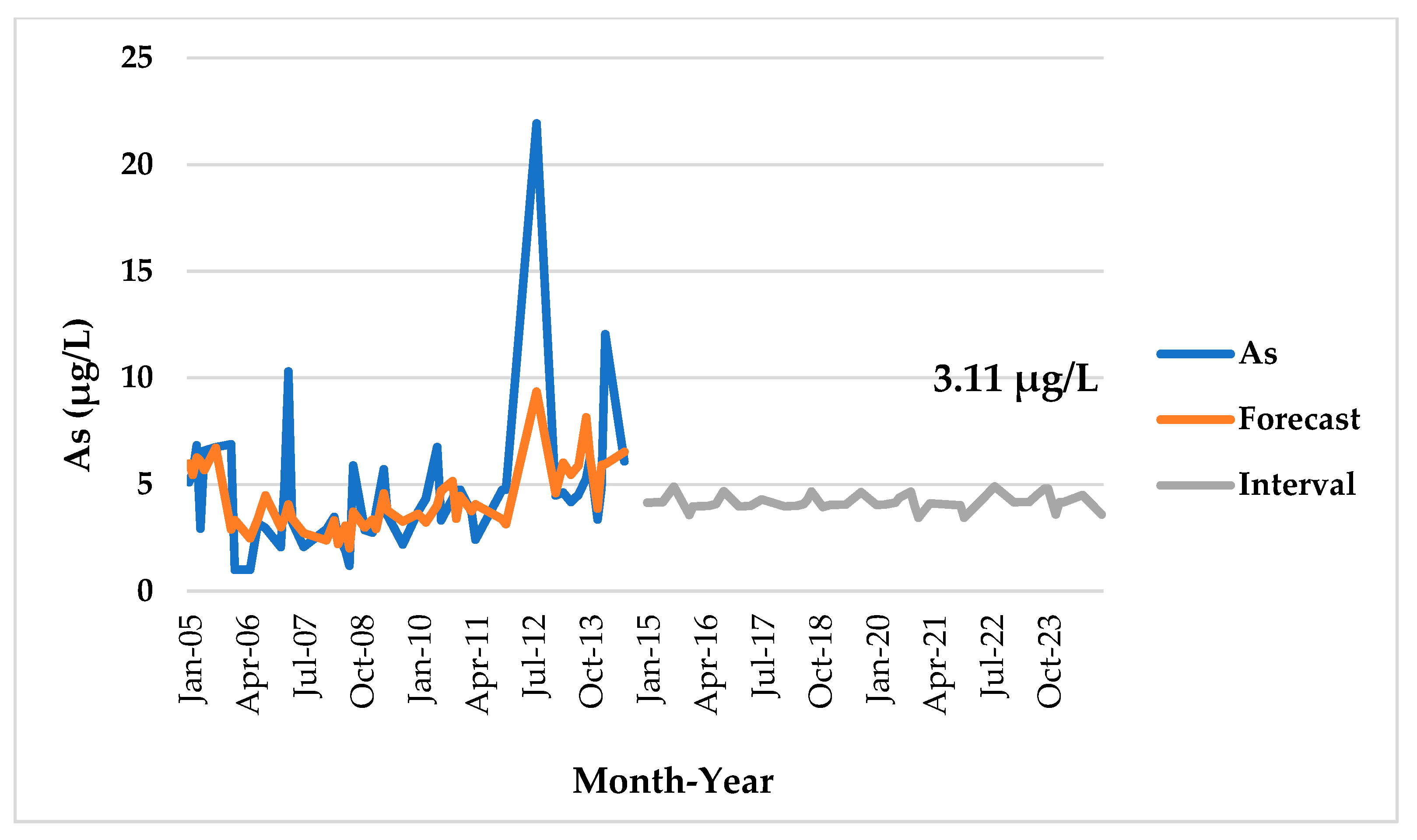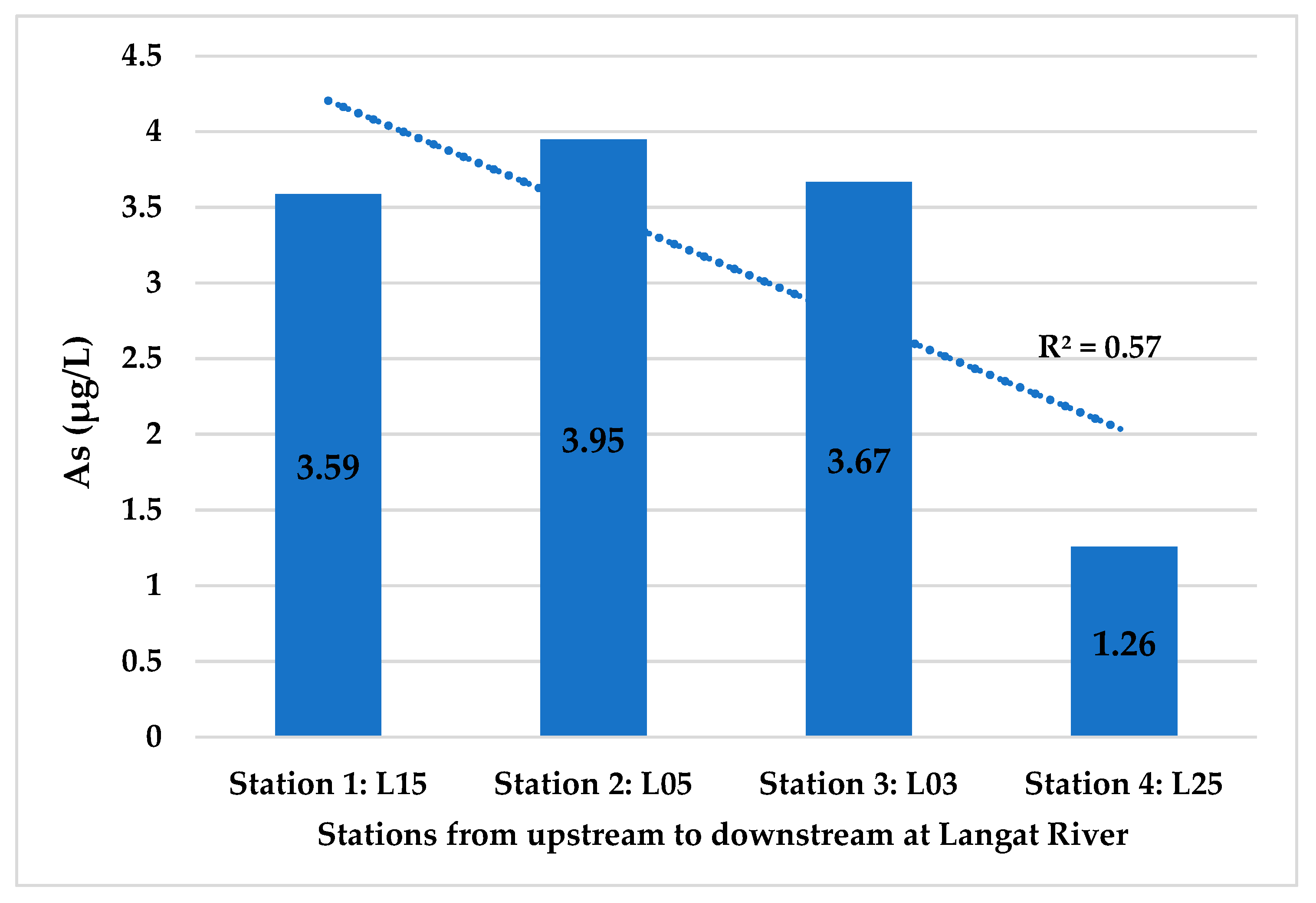Predicting Arsenic (As) Exposure on Human Health for Better Management of Drinking Water Sources
Abstract
1. Introduction
2. Study Area
3. Methods
3.1. Data Collection
3.2. Prediction Model for Arsenic Concentration
3.3. Human Health Risk Assessment
4. Results and Discussion
4.1. Arsenic Concentration in Langat River
4.2. Prediction Model on Arsenic Concentration in Langat River
4.3. Health Risk of Arsenic Ingestion via Drinking Water
5. Conclusions
Supplementary Materials
Author Contributions
Funding
Institutional Review Board Statement
Informed Consent Statement
Data Availability Statement
Acknowledgments
Conflicts of Interest
References
- Shah, A.H.; Shahid, M.; Khalid, S.; Shabbir, Z.; Bakhat, H.F.; Murtaza, B.; Farooq, A.; Akram, M.; Shah, G.M.; Nasim, W.; et al. Assessment of arsenic exposure by drinking well water and associated carcinogenic risk in peri-urban areas of Vehari, Pakistan. Environ. Geochem. Health 2019, 42, 121–133. [Google Scholar] [CrossRef] [PubMed]
- Yadav, K.K.; Gupta, N.; Kumar, V.; Singh, J.K. Bioremediation of heavy metals from contaminated sites using potential species: A review. Indian J. Environ. Prot. 2017, 37, 65–84. [Google Scholar]
- Neamtiu, I.; Bloom, M.S.; Gati, G.; Goessler, W.; Surdu, S.; Pop, C.; Braeuer, S.; Fitzgerald, E.F.; Baciu, C.; Lupsa, I.R.; et al. Pregnant women in Timis County, Romania are exposed primarily to low-level (<10 μg/L) arsenic through residential drinking water consumption. Int. J. Hyg. Environ. Health 2015, 218, 371–379. [Google Scholar] [CrossRef]
- Islam, M.S.; Ahmed, M.K.; Raknuzzaman, M.; Habibullah-Al-Mamun, M.; Islam, M.K. Heavy metal pollution in surface water and sediment: A preliminary assessment of an urban river in a developing country. Ecol. Indic. 2015, 48, 282–291. [Google Scholar] [CrossRef]
- Mohiuddin, K.M.; Ogawa, Y.Z.H.M.; Zakir, H.M.; Otomo, K.; Shikazono, N. Heavy metals contamination in water and sediments of an urban river in a developing country. Int. J. Environ. Sci. Technol. 2011, 8, 723–736. [Google Scholar] [CrossRef]
- Ahmed, M.F.; Mokhtar, M.B.; Alam, L. Carcinogenic and non-carcinogenic health risk of arsenic ingestion via drinking water in Langat River Basin, Malaysia. Environ. Geochem. Health 2021, 43, 897–914. [Google Scholar] [CrossRef]
- He, S.; Wu, J. Hydrogeochemical characteristics, groundwater quality and health risks from hexavalent chromium and nitrate in groundwater of Huanhe Formation in Wuqi County, northwest China. Expo. Health 2019, 11, 125–137. [Google Scholar] [CrossRef]
- He, X.; Wu, J.; He, S. Hydrochemical characteristics and quality evaluation of groundwater in terms of health risks in Luohe aquifer in Wuqi County of the Chinese Loess Plateau, northwest China. Hum. Ecol. Risk Assess. 2019, 25, 32–51. [Google Scholar] [CrossRef]
- Maurya, P.K.; Malik, D.S.; Yadav, K.K.; Kumar, A.; Kumar, S.; Kamyab, H. Bioaccumulation and potential sources of heavy metal contamination in fish species in River Ganga basin: Possible human health risks evaluation. Toxicol. Rep. 2019, 6, 472–481. [Google Scholar] [CrossRef]
- Kumar, S.; Prasad, S.; Yadav, K.K.; Shrivastava, M.; Gupta, N.; Nagar, S.; Bach, Q.; Kamyab, H.; Khan, S.A.; Yadav, S.; et al. Hazardous heavy metals contamination of vegetables and food chain: Role of sustainable remediation approaches-A review. Environ. Res. 2019, 179, 108792. [Google Scholar] [CrossRef]
- Karunanidhi, D.; Aravinthasamy, P.; Subramani, T.; Roy, P.D.; Srinivasamoorthy, K. Risk of fluoride-rich groundwater on human health: Remediation through managed aquifer recharge in a hard rock terrain, South India. Nat. Resour. Res. 2019, 29, 2369–2395. [Google Scholar] [CrossRef]
- Karunanidhi, D.; Aravinthasamy, P.; Subramani, T.; Wu, J.; Srinivasamoorthy, K. Potential health risk assessment for fluoride and nitrate contamination in hard rock aquifers of Shanmuganadhi River basin, South India. Hum. Ecol. Risk Assess. An. Int. J. 2019, 25, 250–270. [Google Scholar] [CrossRef]
- Ötleş, S.; Çağındı, Ö. Health importance of arsenic in drinking water and food. Environ. Geochem. Health 2010, 32, 367–371. [Google Scholar] [CrossRef]
- Aris, A.Z.; Lim, W.Y.; Looi, L.J. Natural and anthropogenic determinants of freshwater ecosystem deterioration: An environmental forensic study of the Langat River Basin, Malaysia. In Environmental Management of River Basin Ecosystems; Ramkumar, M., Ed.; Springer: Cham, Switzerland, 2015; pp. 455–476. [Google Scholar]
- Al-Badaii, F.; Shuhaimi-Othman, M. Heavy metals and water quality assessment using multivariate statistical techniques and water quality index of the Semenyih River, Peninsular Malaysia. Iran. J. Energy Environ. 2014, 5, 132–145. [Google Scholar] [CrossRef][Green Version]
- Islam, M.R.; Salminen, R.; Lahermo, P.W. Arsenic and other toxic elemental contamination of groundwater, surface water and soil in Bangladesh and its possible effects on human health. Environ. Geochem. Health 2000, 22, 33–53. [Google Scholar] [CrossRef]
- Peryea, F.J. Historical use of lead arsenate insecticides, resulting soil contamination and implications for soil remediation. In Proceedings of the Paper Presented at the 16th World Congress of Soil Science, Montpellier, France, 20–26 August 1998. [Google Scholar]
- Sarmani, S.B. The Determination of Heavy Metals in Water, Suspended Materials and Sediments from Langat River, Malaysia Sediment/Water Interactions; Springer: Dordrecht, Belgium, 1989; pp. 233–238. [Google Scholar]
- Yusuf, M.A. River Water Quality and Ecosystem Health in Langat River Basin, Selangor, Malaysia. Ph.D. Thesis, Universiti Kebangsaan Malaysia, UKM Bangi, Selangor, Malaysia, 2001. [Google Scholar]
- DOE. Environment Quality Report 2019; Department of Environment (DOE): Putrajaya, Malaysia, 2019; ISSN 2636-9834. [Google Scholar]
- LUAS. Sungai Langat Basin Management Plan 2015–2020; Lembaga Urus Air Selangor (LUAS): Shah Alam, Malaysia, 2015. Available online: https://www.luas.gov.my/v3/images/penerbitan/PelanIRBM/Langat/Ringkasan%20Eksekutif%20IRBM%20Sg.%20Langat,%202015-2020.pdf (accessed on 10 January 2021).
- DOE. Environment Quality Report 2017; Department of Environment (DOE): Putrajaya, Malaysia, 2017; ISSN 2636-9834. [Google Scholar]
- DOE. Environment Quality Report 2015; Department of Environment (DOE): Putrajaya, Malaysia, 2015; ISBN 978-983-9795-29-5. [Google Scholar]
- Ahmed, M.F.; Mokhtar, M.B. Assessing cadmium and chromium concentrations in drinking water to predict health risk in Malaysia. Int. J. Environ. Res. Public Health 2020, 17, 2966. [Google Scholar] [CrossRef] [PubMed]
- Ahmed, M.F.; Mokhtar, M.B. Treated water quality based on conventional method in Langat River Basin, Malaysia. Environ. Earth Sci. 2020, 79, 1–16. [Google Scholar] [CrossRef]
- Ahmed, M.F.; Mokhtar, M.B.; Alam, L.; Mohamed, C.A.R.; Ta, G.C. Non-carcinogenic health risk assessment of aluminium ingestion via drinking water in Malaysia. Expo. Health 2019, 11, 167–180. [Google Scholar] [CrossRef]
- Ahmed, M.F.; Mokhtar, M.B.; Majid, N.A. Household water filtration technology to ensure safe drinking water supply in the Langat River Basin, Malaysia. Water 2021, 13, 1032. [Google Scholar] [CrossRef]
- FMT. Selangor Spared Further Water Cuts, Thanks to Quick Action in 2 New Cases; FMT Media Sdn. Bhd., Free Malaysia Today: Petaling Jaya, Selangor, Malaysia, 2020; Available online: https://www.freemalaysiatoday.com/category/nation/2020/10/23/selangor-spared-further-water-cuts-thanks-to-quick-action-in-2-new-cases/ (accessed on 5 January 2021).
- Ahmed, M.F.; Alam, L.; Ta, G.C.; Mohamed, C.A.R.; Mokhtar, M. A review on the environmental pollution of Langat River, Malaysia. Asian J. Water Environ. Pollut. 2016, 13, 25–31. [Google Scholar] [CrossRef]
- Sauvé, S.; Desrosiers, M. A review of what is an emerging contaminant. Chem. Cent. J. 2014, 8, 1–7. [Google Scholar] [CrossRef] [PubMed]
- Ahmed, M.F.; Mokhtar, M.; Alam, L.; Ta, G.C.; Lee, K.E.; Khalid, R.M. Recognition of local authority for better management of drinking water at the Langat River Basin, Malaysia. Int. J. Eng. Technol. 2018, 7, 148–154. [Google Scholar] [CrossRef]
- Ahmed, M.F.; Mokhtar, M.B.; Alam, L. Factors influencing people’s willingness to participate in sustainable water resources management in Malaysia. J. Hydrol. Reg. Stud. 2020, 31, 100737. [Google Scholar] [CrossRef]
- Mokhtar, M.B.; Toriman, M.E.H.; Hossain, A.A. Social learning in facing challenges of sustainable development: A case of Langat River Basin, Malaysia. Res. J. Appl. Sci. 2010, 5, 434–443. [Google Scholar]
- Mokhtar, M.B.; Toriman, M.E.H.; Hossain, M.; Abraham, A.; Tan, K.W. Institutional challenges for integrated river basin management in Langat River Basin, Malaysia. Water Environ. J. 2011, 25, 495–503. [Google Scholar] [CrossRef]
- Juahir, H.H. Water Quality Data Analysis and Modeling of the Langat River Basin. Ph.D. Thesis, University of Malaya, Kuala Lumpur, Malaysia, 2009. Available online: http://repository.um.edu.my/1223/5/Chapter%203%20Revised.pdf (accessed on 7 February 2015).
- Juahir, H.; Zain, S.M.; Yusoff, M.K.; Hanidza, T.T.; Armi, A.M.; Toriman, M.E.; Mokhtar, M. Spatial water quality assessment of Langat River Basin (Malaysia) using environmetric techniques. Environ. Monit. Assess. 2011, 173, 625–641. [Google Scholar] [CrossRef] [PubMed]
- MMD. Rainfall and Temperature Data of Langat River Basin Malaysia during 2005 to 2016; Malaysian Meteorological Department (MMD): Putrajaya, Malaysia, 2017. [Google Scholar]
- Friedman, J. Greedy function approximation: A gradient boosting machine. Ann. Stat. 2001, 29, 1189–1232. [Google Scholar] [CrossRef]
- Hubáček, O.; Šourek, G.; Železný, F. Learning to predict soccer results from relational data with gradient boosted trees. Mach. Learn. 2019, 108, 29–47. [Google Scholar] [CrossRef]
- Persson, C.; Bacher, P.; Shiga, T.; Madsen, H. Multi-site solar power forecasting using gradient boosted regression trees. Sol. Energy 2017, 150, 423–436. [Google Scholar] [CrossRef]
- Ebrahimi, M.; Mohammadi-Dehcheshmeh, M.; Ebrahimie, E.; Petrovski, K.R. Comprehensive analysis of machine learning models for prediction of sub-clinical mastitis: Deep Learning and Gradient-Boosted Trees outperform other models. Comput. Biol. Med. 2019, 114, 103456. [Google Scholar] [CrossRef]
- USEPA. Possible Toxicity of Aluminum; United States Environmental Protection Agency: Washington, DC, USA, 1989. Available online: https://nepis.epa.gov/Exe/ZyPDF.cgi/P100NEXM.PDF?Dockey=P100NEXM.PDF (accessed on 18 December 2017).
- USEPA. Guidance for Data Useability in Risk Assessment (Part A); United States Environmental Protection Agency: Washington, DC, USA, 1991. Available online: https://rais.ornl.gov/documents/USERISKA.pdf (accessed on 7 December 2017).
- Adimalla, N.; Li, P. Occurrence, health risks and geochemical mechanisms of fluoride and nitrate in groundwater of the rock-dominant semi-arid region, Telangana State, India. Hum. Ecol. Risk Assess. 2019, 25, 81–103. [Google Scholar] [CrossRef]
- Li, P.; He, X.; Guo, W. Spatial groundwater quality and potential health risks due to nitrate ingestion through drinking water: A case study in Yan’an City on the Loess Plateau of northwest China. Hum. Ecol. Risk Assess. 2019, 25, 11–31. [Google Scholar] [CrossRef]
- Li, P.; He, X.; Li, Y.; Xiang, G. Occurrence and health implication of fluoride in groundwater of loess aquifer in the chinese loess plateau: A case study of Tongchuan, northwest China. Expo. Health 2019, 11, 95–107. [Google Scholar] [CrossRef]
- Li, P.; Li, X.; Meng, X.; Li, M.; Zhang, Y. Appraising groundwater quality and health risks from contamination in a semiarid region of northwest China. Expo. Health 2016, 8, 361–379. [Google Scholar] [CrossRef]
- Wu, J.; Xue, C.; Tian, R.; Wang, S. Lake water quality assessment: A case study of Shahu Lake in the semiarid loess area of northwest China. Environ. Earth Sci. 2017, 76, 232. [Google Scholar] [CrossRef]
- Zhang, Y.; Wu, J.; Xu, B. Human health risk assessment of groundwater nitrogen pollution in Jinghui canal irrigation area of the loess region, northwest China. Environ. Earth Sci. 2018, 77, 273. [Google Scholar] [CrossRef]
- Ab Razak, N.H.; Praveena, S.M.; Aris, A.Z.; Hashim, Z. Quality of Kelantan drinking water and knowledge, attitude and practice among the population of Pasir Mas, Malaysia. Public Health 2016, 131, 103–111. [Google Scholar] [CrossRef] [PubMed]
- USEPA. IRIS Assessments; United States Environmental Protection Agency: Washington, DC, USA, 2016. Available online: https://cfpub.epa.gov/ncea/iris2/atoz.cfm (accessed on 17 November 2017).
- DOE. National Water Quality Standards for Malaysia; Department of Environment (DOE): Putrajaya, Malaysia, 2016. Available online: https://www.doe.gov.my/portalv1/wp-content/uploads/2019/05/Standard-Kualiti-Air-Kebangsaan.pdf (accessed on 20 March 2019).
- MOH. Drinking Water Quality Standard; Engineering Services Division, Ministry of Health (MOH): Putrajaya, Malaysia, 2010. Available online: http://kmam.moh.gov.my/public-user/drinking-water-quality-standard.html (accessed on 25 February 2018).
- WHO. Guidelines for Drinking-Water Quality: Fourth Edition Incorporating the First Addendum; World Health Organization: Geneva, Switzerland, 2017; Available online: http://apps.who.int/iris/bitstream/10665/254637/1/9789241549950-eng.pdf?ua=1 (accessed on 29 May 2017).
- USEPA. Screening Level Ecological Risk Assessment Protocol for Hazardous Waste Combustion Facilities, Toxicity Reference Values (Appendix E), EPA530-D-99-001C (Volume 3); United States Environmental Protection Agency: Washington, DC, USA, 1999.
- Lim, W.Y.; Aris, A.Z.; Praveena, S.M. Application of the chemometric approach to evaluate the spatial variation of water chemistry and the identification of the sources of pollution in Langat River, Malaysia. Arab. J. Geosci. 2013, 6, 4891–4901. [Google Scholar] [CrossRef]
- Lim, W.Y.; Aris, A.Z.; Tengku, I.T.H. Spatial geochemical distribution and sources of heavy metals in the sediment of Langat River, Western Peninsular Malaysia. Environ. Forensics 2013, 14, 133–145. [Google Scholar] [CrossRef]
- Al-Badaii, F.; Halim, A.A.; Shuhaimi-Othman, M. Evaluation of dissolved heavy metals in water of the Sungai Semenyih (Peninsular Malaysia) using environmetric methods. Sains Malays. 2016, 45, 841–852. [Google Scholar]
- ASM. Transforming the Water Sector: National Integrated Water Resources Management Plan, Strategies and Road Map; Academy of Sciences Malaysia (ASM): Kuala Lumpur, Malaysia, 2016; Volume 1, ISBN 978-983-2915-29-4. [Google Scholar]







| State | District | Area (km2) | Local Authority |
|---|---|---|---|
| Selangor | Klang | 71.87 | Majlis Perbandaran Klang (MPK) |
| Kuala Langat | 706.93 | Majlis Daerah Kuala Langat (MDKL) | |
| Sepang | 333.25 | Majlis Perbandaran Sepang (MPS) | |
| Hulu Langat | 809.34 | Majlis Perbandaran Kajang (MPKj) | |
| Negeri Sembilan | Seremban | 445.12 | Majlis Perbandaran Nilai (MPN) |
| W.P. Putrajaya | - | 39.21 | Perbadanan Putrajaya (PPj) |
| W.P. Kuala Lumpur | - | 3.67 | Dewan Bandaraya Kuala Lumpur (DBKL) |
| Total Area | 2409.39 |
| Water Stations | Parameters | N | t | df | Sig. (2-Tailed) | Mean Difference | 95% Confidence Interval of the Difference | |
|---|---|---|---|---|---|---|---|---|
| Lower | Upper | |||||||
| 1L03 | As (μg/L) | 120 | 22.19 | 119 | 1 × 10−3 | 3.64 | 3.31 | 3.96 |
| DO (mg/L) | 120 | 89.06 | 119 | 1 × 10−13 | 5.85 | 5.72 | 5.98 | |
| pH | 120 | 232.50 | 119 | 1 × 10−13 | 6.98 | 6.92 | 7.04 | |
| Temp °C | 120 | 227.87 | 119 | 1 × 10−13 | 28.52 | 28.27 | 28.77 | |
| SAL (ppt) | 120 | 2.13 | 119 | 0.04 | 0.12 | 0.01 | 0.24 | |
| DS (mg/L) | 120 | 19.02 | 119 | 1 × 10−13 | 72.82 | 65.24 | 80.40 | |
| 1L15 | As (μg/L) | 120 | 18.06 | 119 | 1 × 10−3 | 4.74 | 4.22 | 5.26 |
| DO (mg/L) | 120 | 71.15 | 119 | 1 × 10−13 | 6.66 | 6.47 | 6.84 | |
| pH | 120 | 241.10 | 119 | 1 × 10−13 | 7.05 | 6.99 | 7.11 | |
| Temp °C | 120 | 253.52 | 119 | 1 × 10−13 | 27.15 | 26.94 | 27.36 | |
| SAL (ppt) | 120 | 23.70 | 119 | 1 × 10−13 | 0.05 | 0.05 | 0.06 | |
| DS (mg/L) | 120 | 18.67 | 119 | 1 × 10−13 | 57.29 | 51.22 | 63.37 | |
| 1L05 | As (μg/L) | 120 | 21.16 | 119 | 1 × 10−3 | 4.96 | 4.49 | 5.42 |
| DO (mg/L) | 120 | 57.26 | 119 | 1 × 10−13 | 5.54 | 5.35 | 5.73 | |
| pH | 120 | 275.22 | 119 | 1 × 10−13 | 7.02 | 6.96 | 7.07 | |
| Temp °C | 120 | 189.24 | 119 | 1 × 10−13 | 28.15 | 27.85 | 28.44 | |
| SAL (ppt) | 120 | 29.33 | 119 | 1 × 10−13 | 0.07 | 0.06 | 0.07 | |
| DS (mg/L) | 120 | 23.50 | 119 | 1 × 10−13 | 75.55 | 69.18 | 81.91 | |
| 1L25 | As (μg/L) | 120 | 27.70 | 119 | 1 × 10−3 | 1.57 | 1.46 | 1.69 |
| DO (mg/L) | 120 | 119.41 | 119 | 1 × 10−13 | 6.91 | 6.79 | 7.02 | |
| pH | 120 | 185.93 | 119 | 1 × 10−13 | 29.46 | 29.15 | 29.78 | |
| Temp °C | 120 | 47.90 | 119 | 1 × 10−13 | 0.03 | 0.03 | 0.03 | |
| SAL (ppt) | 120 | 33.29 | 119 | 1 × 10−13 | 37.46 | 35.23 | 39.68 | |
| DS (mg/L) | 120 | 119.41 | 119 | 1 × 10−13 | 6.91 | 6.79 | 7.02 | |
| Water Stations | Parameter | N | Minimum | Maximum | Mean | Std. Deviation |
|---|---|---|---|---|---|---|
| 1L15 | As (μg/L) | 120 | 1.00 | 21.94 | 4.74 | 2.87 |
| DO (mg/L) | 120 | 3.31 | 8.67 | 6.66 | 1.02 | |
| pH | 120 | 5.67 | 7.92 | 7.05 | 0.32 | |
| Temp °C | 120 | 24.67 | 30.61 | 27.15 | 1.17 | |
| SAL (ppt) | 120 | 0.02 | 0.13 | 0.05 | 0.02 | |
| DS (mg/L) | 120 | 20.00 | 185.00 | 57.29 | 33.62 | |
| 1L05 | As (μg/L) | 120 | 1.00 | 15.04 | 4.96 | 2.57 |
| DO (mg/L) | 120 | 2.39 | 7.77 | 5.54 | 1.06 | |
| pH | 120 | 5.84 | 7.73 | 7.02 | 0.28 | |
| Temp °C | 120 | 24.67 | 33.00 | 28.15 | 1.63 | |
| SAL (ppt) | 120 | 0.03 | 0.13 | 0.07 | 0.03 | |
| DS (mg/L) | 120 | 28.00 | 179.00 | 75.55 | 35.22 | |
| 1L03 | As (μg/L) | 120 | 0.98 | 10.60 | 3.64 | 1.80 |
| DO (mg/L) | 120 | 3.55 | 7.62 | 5.85 | 0.72 | |
| pH | 120 | 6.07 | 8.28 | 6.98 | 0.33 | |
| Temp °C | 120 | 25.26 | 32.34 | 28.52 | 1.37 | |
| SAL (ppt) | 120 | 0.02 | 7.00 | 0.12 | 0.63 | |
| DS (mg/L) | 120 | 26.00 | 265.00 | 72.82 | 41.95 | |
| 1L25 | As (μg/L) | 120 | 0.94 | 3.88 | 1.57 | 0.62 |
| DO (mg/L) | 120 | 4.68 | 8.84 | 6.91 | 0.63 | |
| pH | 120 | 24.17 | 34.28 | 29.46 | 1.74 | |
| Temp °C | 120 | 0.02 | 0.06 | 0.03 | 0.01 | |
| SAL (ppt) | 120 | 18.00 | 83.00 | 37.46 | 12.33 | |
| DS (mg/L) | 120 | 4.68 | 8.84 | 6.91 | 0.63 | |
| Average | As (μg/L) | 120 | 0.98 | 12.87 | 3.73 | 1.97 |
| DO 4 (mg/L) | 120 | 3.48 | 8.23 | 6.24 | 0.86 | |
| pH 4 | 120 | 10.44 | 14.55 | 12.63 | 0.67 | |
| Temp 5 °C | 120 | 18.66 | 24.00 | 20.96 | 1.05 | |
| SAL 6 (ppt) | 120 | 4.52 | 22.57 | 9.43 | 3.25 | |
| DS 7 (mg/L) | 120 | 19.67 | 159.46 | 53.14 | 27.86 | |
| MOH 1 | As (μg/L) | 10 | ||||
| WHO 2 | As (μg/L) | 10 | ||||
| USEPA 3 | As (μg/L) | 150 |
| Parameters | Correlation | As (μg/L) | DO (mg/L) | pH | Temp °C | SAL (ppt) | DS (mg/L) |
|---|---|---|---|---|---|---|---|
| As (μg/L) | Pearson Correlation | 1 | |||||
| Sig. (1-tailed) | |||||||
| N | 120 | ||||||
| DO (mg/L) | Pearson Correlation | −0.524 ** | 1 | ||||
| Sig. (1-tailed) | 4.2 × 10−10 | ||||||
| N | 120 | 120 | |||||
| pH | Pearson Correlation | 0.096 | 0.121 | 1 | |||
| Sig. (1-tailed) | 0.149 | 0.095 | |||||
| N | 120 | 120 | 120 | ||||
| Temp °C | Pearson Correlation | 0.229 ** | −0.304 ** | −0.047 | 1 | ||
| Sig. (1-tailed) | 0.006 | 3.61 × 10−4 | 0.307 | ||||
| N | 120 | 120 | 120 | 120 | |||
| SAL (ppt) | Pearson Correlation | 0.092 | −0.052 | 0.072 | −0.002 | 1 | |
| Sig. (1-tailed) | 0.158 | 0.285 | 0.219 | 0.491 | |||
| N | 120 | 120 | 120 | 120 | 120 | ||
| DS (mg/L) | Pearson Correlation | 0.704 ** | −0.648 ** | 0.112 | 0.227 ** | 0.156 * | 1 |
| Sig. (1-tailed) | 1 × 10−13 | 1.01 × 10−13 | 0.112 | 0.006 | 0.045 | ||
| N | 120 | 120 | 120 | 120 | 120 | 120 |
Publisher’s Note: MDPI stays neutral with regard to jurisdictional claims in published maps and institutional affiliations. |
© 2021 by the authors. Licensee MDPI, Basel, Switzerland. This article is an open access article distributed under the terms and conditions of the Creative Commons Attribution (CC BY) license (https://creativecommons.org/licenses/by/4.0/).
Share and Cite
Ahmed, M.F.; Lim, C.K.; Mokhtar, M.B.; Khirotdin, R.P.K. Predicting Arsenic (As) Exposure on Human Health for Better Management of Drinking Water Sources. Int. J. Environ. Res. Public Health 2021, 18, 7997. https://doi.org/10.3390/ijerph18157997
Ahmed MF, Lim CK, Mokhtar MB, Khirotdin RPK. Predicting Arsenic (As) Exposure on Human Health for Better Management of Drinking Water Sources. International Journal of Environmental Research and Public Health. 2021; 18(15):7997. https://doi.org/10.3390/ijerph18157997
Chicago/Turabian StyleAhmed, Minhaz Farid, Chen Kim Lim, Mazlin Bin Mokhtar, and Rd. Puteri Khairani Khirotdin. 2021. "Predicting Arsenic (As) Exposure on Human Health for Better Management of Drinking Water Sources" International Journal of Environmental Research and Public Health 18, no. 15: 7997. https://doi.org/10.3390/ijerph18157997
APA StyleAhmed, M. F., Lim, C. K., Mokhtar, M. B., & Khirotdin, R. P. K. (2021). Predicting Arsenic (As) Exposure on Human Health for Better Management of Drinking Water Sources. International Journal of Environmental Research and Public Health, 18(15), 7997. https://doi.org/10.3390/ijerph18157997







